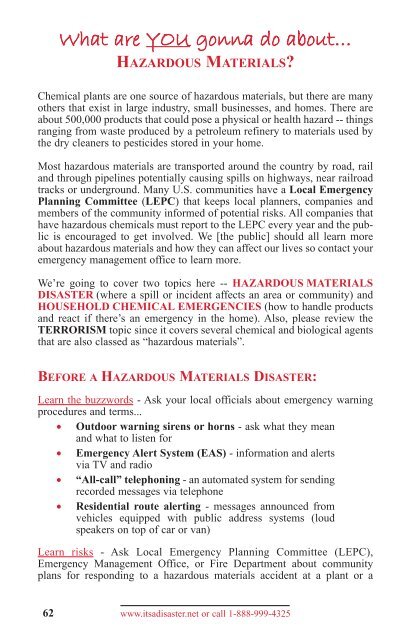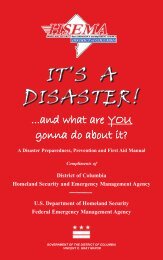disaster 5th 1108_5th ed 2011 - Homeland Security and Emergency ...
disaster 5th 1108_5th ed 2011 - Homeland Security and Emergency ...
disaster 5th 1108_5th ed 2011 - Homeland Security and Emergency ...
You also want an ePaper? Increase the reach of your titles
YUMPU automatically turns print PDFs into web optimized ePapers that Google loves.
What are YOU gonna do about…<br />
HAZARDOUS MATERIALS<br />
Chemical plants are one source of hazardous materials, but there are many<br />
others that exist in large industry, small businesses, <strong>and</strong> homes. There are<br />
about 500,000 products that could pose a physical or health hazard -- things<br />
ranging from waste produc<strong>ed</strong> by a petroleum refinery to materials us<strong>ed</strong> by<br />
the dry cleaners to pesticides stor<strong>ed</strong> in your home.<br />
Most hazardous materials are transport<strong>ed</strong> around the country by road, rail<br />
<strong>and</strong> through pipelines potentially causing spills on highways, near railroad<br />
tracks or underground. Many U.S. communities have a Local <strong>Emergency</strong><br />
Planning Committee (LEPC) that keeps local planners, companies <strong>and</strong><br />
members of the community inform<strong>ed</strong> of potential risks. All companies that<br />
have hazardous chemicals must report to the LEPC every year <strong>and</strong> the public<br />
is encourag<strong>ed</strong> to get involv<strong>ed</strong>. We [the public] should all learn more<br />
about hazardous materials <strong>and</strong> how they can affect our lives so contact your<br />
emergency management office to learn more.<br />
We’re going to cover two topics here -- HAZARDOUS MATERIALS<br />
DISASTER (where a spill or incident affects an area or community) <strong>and</strong><br />
HOUSEHOLD CHEMICAL EMERGENCIES (how to h<strong>and</strong>le products<br />
<strong>and</strong> react if there’s an emergency in the home). Also, please review the<br />
TERRORISM topic since it covers several chemical <strong>and</strong> biological agents<br />
that are also class<strong>ed</strong> as “hazardous materials”.<br />
BEFORE A HAZARDOUS MATERIALS DISASTER:<br />
Learn the buzzwords - Ask your local officials about emergency warning<br />
proc<strong>ed</strong>ures <strong>and</strong> terms...<br />
• Outdoor warning sirens or horns - ask what they mean<br />
<strong>and</strong> what to listen for<br />
• <strong>Emergency</strong> Alert System (EAS) - information <strong>and</strong> alerts<br />
via TV <strong>and</strong> radio<br />
• “All-call” telephoning - an automat<strong>ed</strong> system for sending<br />
record<strong>ed</strong> messages via telephone<br />
• Residential route alerting - messages announc<strong>ed</strong> from<br />
vehicles equipp<strong>ed</strong> with public address systems (loud<br />
speakers on top of car or van)<br />
Learn risks - Ask Local <strong>Emergency</strong> Planning Committee (LEPC),<br />
<strong>Emergency</strong> Management Office, or Fire Department about community<br />
plans for responding to a hazardous materials accident at a plant or a<br />
62 www.itsa<strong>disaster</strong>.net or call 1-888-999-4325





